Hemigrapsus oregonensis (Dana, 1851)Common name(s): Yellow shore cab, Mud-flat crab, Oregon shore crab, Hairy shore crab, Green shore crab |
|
| Synonyms: Pseudograpsus oregonensis, Brachynotus oregonensis |  |
| Phylum Arthropoda
Subphylum Crustacea Class Malacostraca Subclass Eumalacostraca Superorder Eucarida Order Decapoda Suborder Pleocyemata Infraorder Brachyura (true crabs) Family Varunidae |
|
| Hemigrapsus oregonensis from Sares Head. | |
| (Photo by: Dave Cowles July 2005) | |
How to Distinguish from Similar Species: Pachygrapsus crassipes, which lives mostly farther south, has transverse ridges on the dorsal surface of its carapace and 2 teeth on the anterolateral margin of the carapace. Hemigrapsus nudus has few or no setae on the legs and purple spots on the chelipeds.
The first zoeal stage of H. oregonensis can be distinguished from zoeae of H. nudus because H. oregonensis has lateral projections on only abdominal segment 2 while H. nudus has lateral projections on abdominal segments 2 and 3 (Lee and Ko, 2008)
Geographical Range: Resurrection Bay, Alaska to Bahia de Todos Santos, Baja California.
Depth Range: (mainly intertidal)
Habitat: Open mud flats, algal mats and eelgrass beds, in bays and estuaries and on open beaches where there is plenty of fine sediment.
Biology/Natural History:
This species is
a better osmoregulator than the other local shore crabs (H.
nudus), which is probably associated with its being more
common in
estuaries. It also often digs burrows and is capable of
withstanding
more hypoxic conditions than the other shore crabs are. Feeds
mainly
at night, mostly on diatoms and green algae, but will eat meat if it
has
opportunity. Predators include shorebirds. May have
the parasitic
isopod Portunion conformis in the perivisceral
cavity (not evident
unless dissected).
| Return to: | |||
| Main Page | Alphabetic Index | Systematic Index | Glossary |
References:
Dichotomous Keys:Coffin, 1952
Flora and Fairbanks, 1966
Hart, 1982
Kozloff 1987, 1996
Smith and Carlton, 1975
Wicksten, 2009
General References:
Kozloff,
1993
Morris
et al., 1980
Ricketts
et al., 1985
Scientific Articles:
Burnett, Nicole, 2024: A practical identification guide to the zoeae of the invasive European green crab, Carcinus maenas (Linnaeus, 1758) (Decapoda: Brachyura: Carcinidae), and to the zoeae of the families of brachyuran crabs in Washington state, USA. Journal of Crustacean Biology 44:4. doi.org/10.1093/jcbiol/ruae064
Lee,
Seok Hyun and Hyun Sook Ko, 2008. First zoeal
stages of six species
of Hemigrapsus
(Decapoda:
Brachyura: Grapsidae) from the northern Pacific including an
identification
key. Journal of Crustacean Biology 28:4 pp. 675-685
General Notes and Observations: Locations, abundances, unusual behaviors:
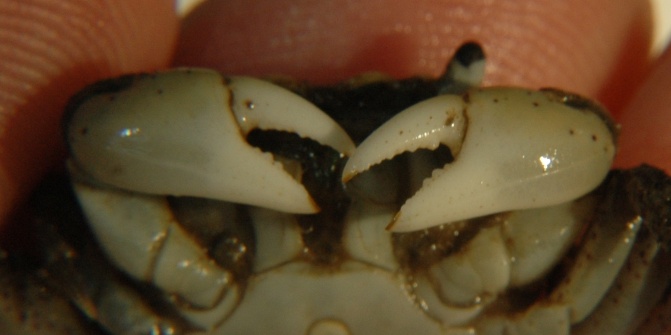
The chelae in this species does not have purple spots, as does H.
nudus.

The legs of H. oregonensis have setae, as visible
here.

View of the underside of a female (left) and a male (right).
Note the broader, more rounded abdomen on the female and the narrower,
pointed abdomen on the male.
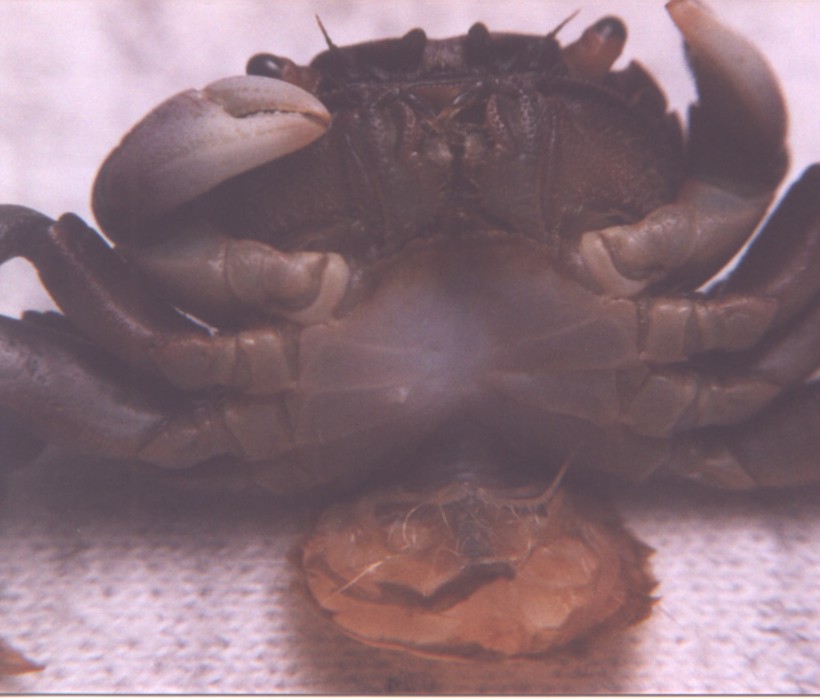
Closeup of the underside of the abdomen of a female. Females
in brachyuran crabs have pleopods on their abdomens which function to
attach
eggs to.
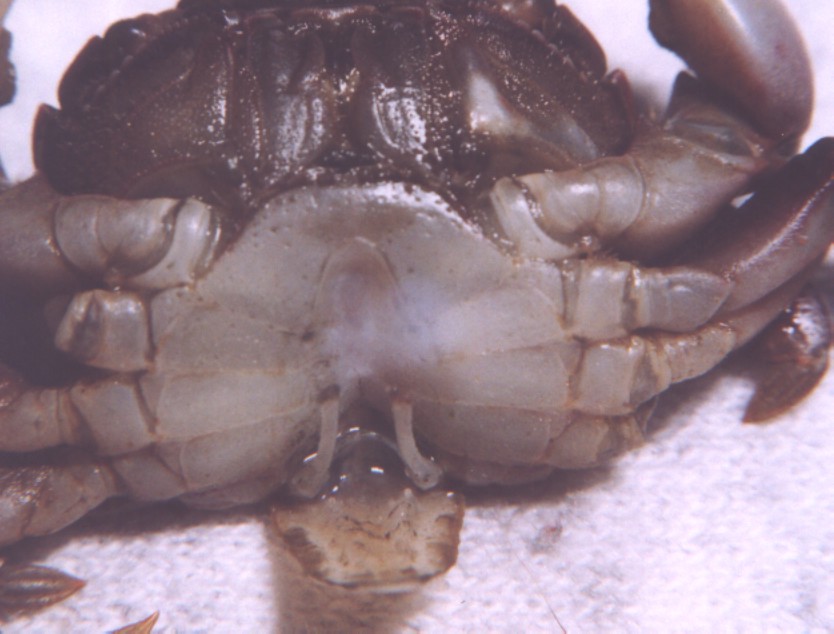
View of the underside of a male Hemigrapsus oregonensis.
Male brachyuran crabs have no pleopods on their abdomen except for two
hemipenes used for transferring sperm.
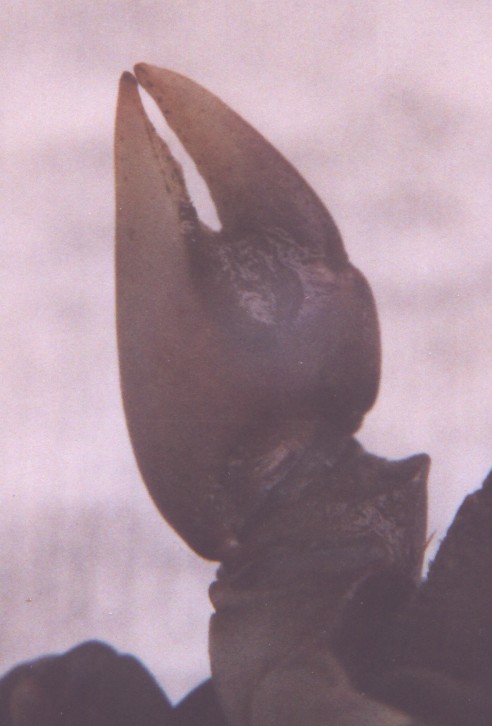
The right chela of a male. There is a tuft of setae on the
palm
of the chela on males.
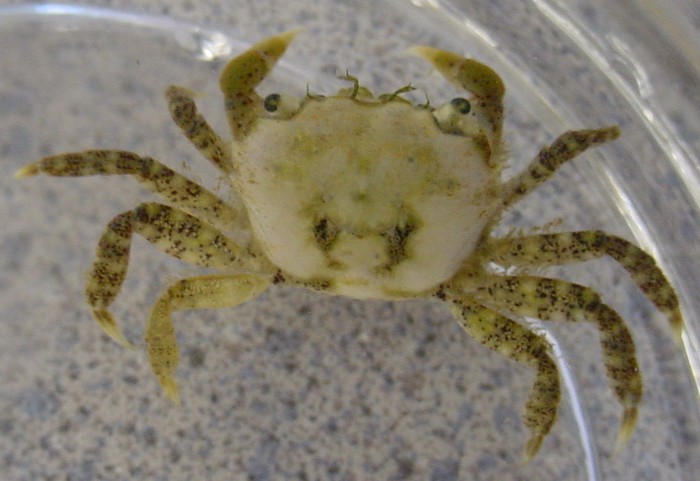
This crab has many color variations. A common form is a white
or nearly white carapace, as seen in this individual. Photo
by Dave
Cowles, July 2005
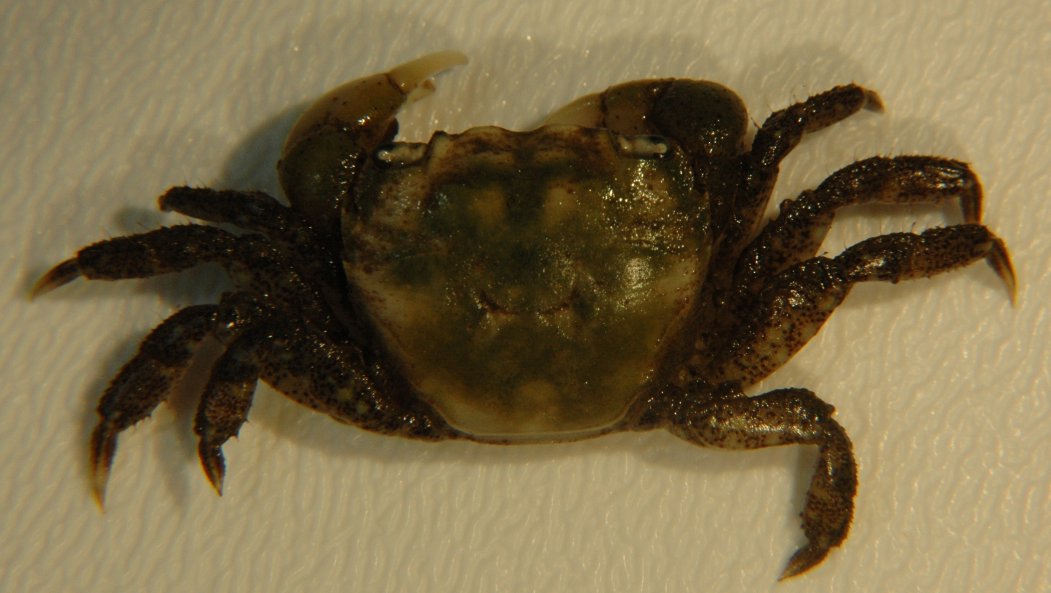
Light green is another common color. Photo by Dave Cowles,
July
2005

This individual from Kalaloch also shows the hairy legs (actually setae
not hairs) common on this species, plus the three teeth on the
anterolateral
margin of the carapace
which distinguish genus Hemigrapsus from Pachygrapsus
crassipes (which has only two teeth).
Although abundant setae
on the legs is characteristic of H. oregonensis and
are evident
in this individual, most individuals found near the Rosario Marine Labs
have very few setae
on the legs.
Photo by Dave Cowles, July 2009
Authors and Editors of Page:
Dave Cowles (2005): Created original page